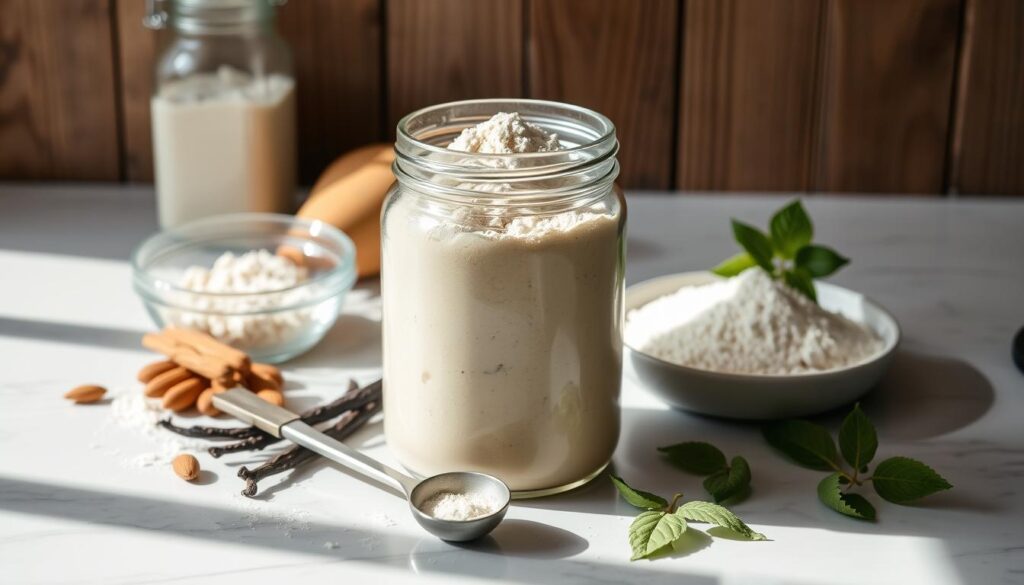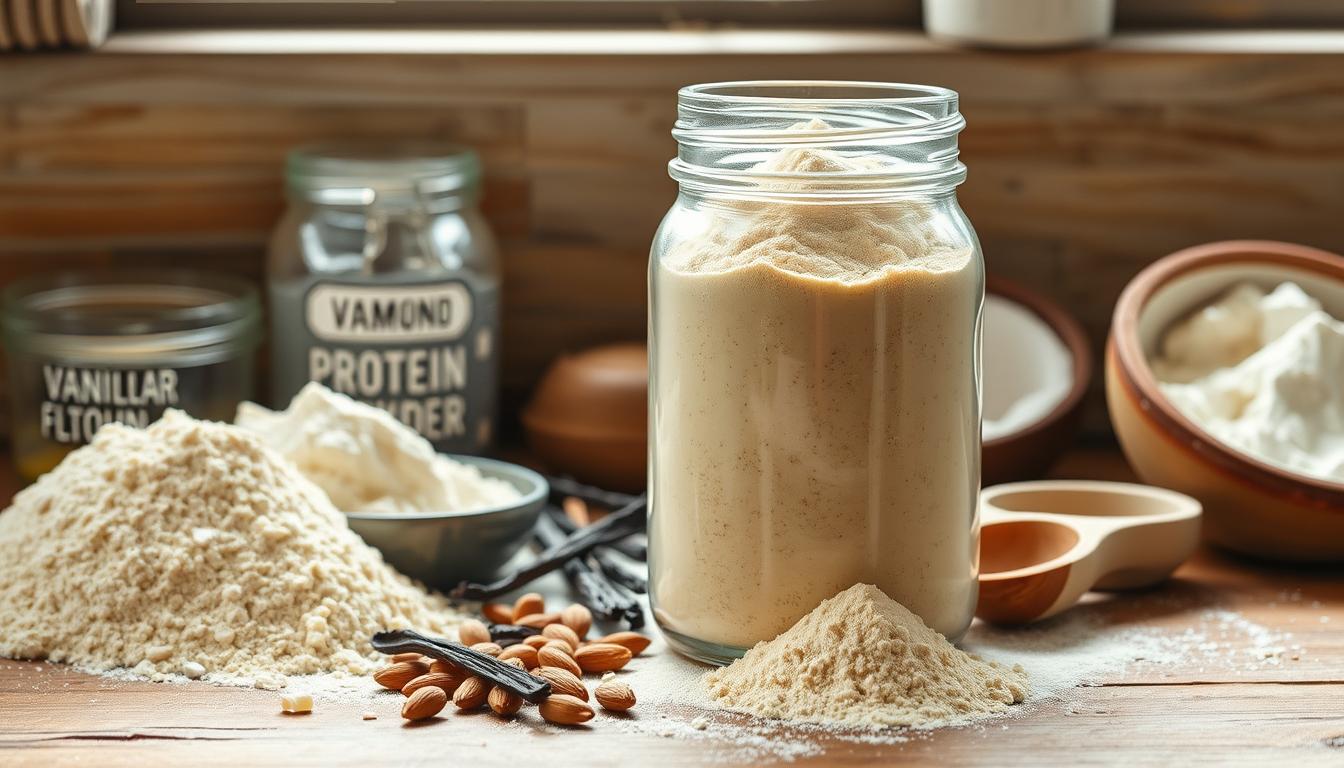Diy Keto Vanilla Protein Powder No Sugar
Table of Contents
Diy Keto Vanilla Protein Powder No Sugar
Starting a ketogenic diet can be challenging, especially when it comes to finding good protein sources. Homemade vanilla protein powder is a great solution for those who want a natural, sugar-free option. It lets you control the ingredients and enjoy the taste of vanilla.

Key Takeaways
- Homemade keto protein powder allows you to control the ingredients and avoid added sugars.
- Natural vanilla flavor enhances the taste of your protein supplement without compromising its keto-friendly profile.
- Crafting your own powder enables you to customize the protein sources to meet your specific macronutrient needs.
- Homemade protein powder is a cost-effective alternative to store-bought options.
- Staying true to the keto diet’s principles is made easier with a sugar-free, low-carb protein powder.
Understanding Keto-Friendly Protein Powder Basics
If you’re on a ketogenic diet, finding the right keto-compatible protein is key. Not all protein powders fit the low-carb, high-fat lifestyle. Knowing about keto-friendly protein powders helps you choose wisely and enjoy the benefits of these supplements.
What Makes a Protein Powder Keto-Compatible?
A protein powder is keto-compatible if it’s low in carbs and high in healthy fats. It should come from quality, nutrient-dense sources. It’s also important to avoid added sugars, fillers, and artificial ingredients to stay in ketosis.
Benefits of Making Your Own Protein Powder
- Complete control over ingredients and macronutrient ratios
- Ability to customize flavors and textures to your preference
- Cost-effectiveness compared to pre-made low-carb protein powders
- Opportunity to incorporate a variety of keto-compatible protein sources
Essential Nutritional Components
When making your own keto-friendly protein powder, focus on these key components:
- High-quality, keto-compatible protein sources (e.g., grass-fed whey, casein, collagen, or plant-based proteins)
- Healthy fats (such as coconut oil, MCT oil, or nut butters) to support ketosis
- Low-carb sweeteners (like stevia, erythritol, or monk fruit) for flavor
- Fiber-rich ingredients (e.g., psyllium husk, ground flaxseed, or chia seeds) for digestive health
- Nutrient-dense superfoods (such as greens, berries, or cocoa powder) for added vitamins and minerals
By understanding these basics, you can make a keto-compatible protein powder that meets your needs. You’ll enjoy the benefits of a nutrient-dense supplement.
Essential Ingredients for Sugar-Free Vanilla Protein Powder
Making a tasty and keto-friendly vanilla protein powder at home needs careful picking of natural protein sources and sugar alternatives. Choosing these keto protein ingredients lets you make a healthy, low-carb powder. It’s perfect for your ketogenic diet.
The base of your homemade keto vanilla protein powder should be top-notch protein. Great natural protein sources include:
- Grass-fed whey protein
- Collagen peptides
- Egg white protein
- Pea protein
To sweeten your powder without sugar, try sugar alternatives like:
- Erythritol
- Monk fruit sweetener
- Stevia
- Xylitol
These natural sweeteners add sweetness without carbs. They’re ideal for keto-friendly recipes.
| Ingredient | Purpose | Recommended Amount |
|---|---|---|
| Grass-fed whey protein | Provides high-quality, keto-friendly protein | 2-3 scoops (20-30g) |
| Erythritol | Sugar alternative for sweetness | 1-2 tablespoons |
| Vanilla extract | Enhances the natural vanilla flavor | 1-2 teaspoons |
| Ground cinnamon (optional) | Adds warmth and depth of flavor | 1/2 teaspoon |
By picking these key keto protein ingredients and sugar alternatives carefully, you can make a homemade vanilla protein powder. It meets your ketogenic diet needs.
Equipment Needed for Making Homemade Protein Powder
Making your own keto-friendly protein powder at home needs a few key tools. You’ll need blending devices and storage solutions to get the best results. Having the right tools can make a big difference in making a high-quality supplement.
Must-Have Kitchen Tools
- Powerful blender or food processor – Essential for thoroughly blending and grinding your protein powder ingredients into a smooth, consistent texture.
- Measuring cups and spoons – Precise measurements are key for achieving the optimal nutrient balance in your homemade powder.
- Airtight storage containers – Proper storage is vital to preserving the freshness and potency of your DIY protein supplement.
Optional Equipment for Enhanced Results
While basic tools are a must, some optional equipment can improve your protein powder-making process:
- High-powered spice or coffee grinder – Transforms whole nuts, seeds, or dried ingredients into an ultra-fine powder for a silkier texture.
- Dehydrator – Allows you to gently dry and concentrate protein-rich ingredients like collagen or egg whites.
- Mesh strainer – Helps sift out any lumps or clumps for a smoother, more uniform final product.
Storage Solutions
Proper storage is key to keeping your homemade protein powder fresh and potent. Invest in high-quality, airtight containers for protein powder blending tools and DIY supplement equipment. This keeps the nutritional value and flavor of your custom blend intact.
With the right tools and storage, you’re ready to make your own delicious, keto-friendly protein powder at home.
Step-by-Step DIY Keto Vanilla Protein Powder No Sugar Recipe
Making your own keto protein powder recipe at home is a great way to get a healthy, sugar-free protein boost. By creating a homemade vanilla protein blend, you can pick the ingredients that fit your keto diet and taste. Let’s explore how to make a tasty sugar-free protein mix in your kitchen.
- Gather your high-quality protein powder, such as grass-fed whey or plant-based options like pea or almond protein.
- Add a generous amount of pure vanilla extract or vanilla bean powder to impart a rich, aromatic flavor.
- Include a sugar-free sweetener of your choice, such as stevia, monk fruit, or erythritol, to taste.
- Optionally, you can blend in healthy fats like coconut oil or MCT oil to enhance the keto-friendly profile.
- Thoroughly mix all the ingredients until you achieve a smooth, uniform consistency.
- Store your homemade keto protein powder in an airtight container in a cool, dry place for optimal freshness.
By following these simple steps, you can make a delicious and nutritious sugar-free protein mix that fits your keto lifestyle. Enjoy this versatile homemade vanilla protein blend in your favorite keto-friendly smoothies, baked goods, or as a standalone protein boost.

“Crafting your own keto-friendly protein powder at home allows you to control the ingredients and ensure it fits your dietary needs perfectly.”
Best Protein Sources for Your Homemade Blend
Creating your own keto-friendly protein powder requires choosing the right protein sources. You can pick from plant-based and animal-based options. This helps make a supplement that’s full of nutrients and fits your vegan keto lifestyle.
Plant-Based Options
For a vegan keto protein powder, consider pea protein, hemp protein, and almond protein. These are low in carbs and have all the amino acids you need. They’re great vegan keto protein options compared to whey-based powders.
Animal-Based Proteins
If you’re okay with animal-based proteins, try whey protein alternatives like grass-fed collagen and egg white protein. They’re part of complete protein blends that give you essential amino acids. These help with muscle recovery and growth.
Protein Combination Strategies
- Combine plant-based and animal-based proteins for a comprehensive amino acid profile.
- Experiment with different ratios to find the perfect balance of macronutrients for your keto lifestyle.
- Incorporate healthy fats, such as coconut oil or MCT powder, to further enhance the ketogenic properties of your homemade protein powder.
By picking and blending the right proteins, you can make a vegan keto protein powder that’s tailored to your needs. It supports your fitness goals on a low-carb, high-fat diet.
Natural Sweetener Options for Keto Protein Powder
Choosing the right sweeteners is key when making keto-friendly protein powder. Regular sugars are not allowed on the keto diet. But, there are many natural, low-carb sweeteners that can add sweetness without ruining your macros.
Some of the most popular keto-friendly sweeteners include:
- Stevia – A plant-based sweetener that’s zero calories and zero carbs, making it an excellent choice for keto diets.
- Monk Fruit – Also known as luo han guo, this unique fruit-derived sweetener is naturally sweet yet low in carbs.
- Erythritol – A sugar alcohol that provides sweetness without the blood sugar spike of regular sugar. It’s a keto-approved option.
These keto-friendly sweeteners not only make your homemade protein powder taste great. They also help keep your carb count low. Try different combinations to find the perfect sweetness for your taste.
| Sweetener | Calories (per tsp) | Carbs (per tsp) | Keto-Friendly |
|---|---|---|---|
| Stevia | 0 | 0 | Yes |
| Monk Fruit | 0 | 0 | Yes |
| Erythritol | 6 | 1.6 | Yes |
When using these keto-friendly sweeteners, you might need to try different amounts. Start with a little and adjust as needed. This way, you can make a protein powder that tastes great and is keto-compliant.
Flavor Enhancement Techniques and Variations
Making a tasty keto-friendly vanilla protein powder is more than just picking the right ingredients. It’s also about knowing how to make flavors pop. By using natural flavorings and trying out new mixtures, you can make your vanilla taste even better. You can also add exciting new flavors to your homemade protein mix.
Natural Vanilla Options
The quality of your vanilla is key to a great vanilla protein powder. While vanilla extract is popular, try using vanilla bean powder instead. This powder, made from real vanilla beans, gives a deep, intense flavor. It can take your protein powder to a whole new level of deliciousness.
Additional Flavor Combinations
To make your keto protein powder even more interesting, mix in some natural flavorings and keto-friendly flavor extracts. Adding cinnamon, nutmeg, or orange zest can give your vanilla a warm, spicy taste. Peppermint or almond extracts can add a refreshing, aromatic twist. The goal is to let the vanilla shine while adding interesting flavors to it.
| Flavor Combination | Potential Benefits |
|---|---|
| Vanilla + Cinnamon | Warm, comforting flavor profile |
| Vanilla + Almond | Nutty, aromatic undertones |
| Vanilla + Peppermint | Refreshing, invigorating touch |
By trying out different natural flavorings and mixtures, you can make a keto vanilla protein powder that’s truly your own. It will match your taste preferences perfectly.
Storage Tips and Shelf Life Guidelines
Keeping your homemade protein powder fresh and potent is key. The right storage can extend the shelf life of your homemade supplement. This ensures it stays high quality.
To keep your protein powder preservation at its best, follow these easy tips:
- Use an airtight container, like a glass jar or BPA-free plastic, to keep air out and freshness in.
- Store it in a cool, dry spot, like a pantry or cabinet. Avoid heat sources and direct sunlight to protect nutrients.
- Adding a desiccant pack or silica gel sachet can help absorb moisture. This can extend the shelf life of your homemade supplement.
| Storage Conditions | Approximate Shelf Life |
|---|---|
| Airtight container, cool, dry place | 6-12 months |
| Refrigerator | 12-18 months |
| Freezer | 18-24 months |
By using these protein powder preservation tips, you can extend the shelf life of your homemade supplement. This way, you can enjoy its benefits for a longer time.
“Proper storage is the key to maintaining the quality and potency of your homemade protein powder.”

Common Mistakes to Avoid When Making Keto Protein Powder
Making keto-friendly protein powder at home needs careful attention. Steer clear of these common mistakes to make sure your homemade supplement tastes great and is healthy. Focus on the right mix of ingredients, how you process it, and how you store it. Mastering these areas will help you make a great protein powder.
Ingredient Proportions
Getting the right amounts of each ingredient is key. Too much or too little of protein, fats, and sweeteners can mess up your mix. Always check the serving sizes and adjust the ratios to keep your mix balanced.
Processing Methods
Blending and drying right is crucial for the perfect texture. Too much blending can make it clumpy or gritty. Not enough can leave flavors and nutrients uneven. Play with your tools and times to get it just right.
Storage Errors
Storing your keto protein powder right is important. Air, moisture, or heat can spoil it. Use airtight containers and keep it in a cool, dry spot. This will keep it fresh and potent for longer.
FAQ
What makes a protein powder keto-compatible?
A keto-compatible protein powder has low carbs and lots of healthy fats. It also has little to no added sugars. This type of protein supports the ketogenic diet by keeping you in ketosis.
What are the benefits of making your own protein powder?
Creating your own protein powder lets you choose the ingredients. It fits your dietary needs perfectly. It’s also cheaper than buying it and you can try different flavors.
What are the essential nutritional components for a keto-friendly protein powder?
A good keto-friendly protein powder has quality protein, healthy fats, and low-carb sweeteners. Choose ingredients that are low in carbs but high in nutrients.
What are the must-have kitchen tools for making homemade protein powder?
You’ll need a strong blender, measuring tools, and containers to store it. A sifter can make the powder smoother.
What are the best protein sources for a keto-friendly vanilla protein powder?
Great protein sources include grass-fed whey, pea, or hemp protein, and egg whites. Mixing different proteins makes it more complete.
What are some natural, keto-friendly sweetener options for homemade protein powder?
Good sweeteners are stevia, monk fruit, and erythritol. They add sweetness without carbs or sugar spikes.
How can I enhance the vanilla flavor in my homemade protein powder?
Use vanilla bean powder or quality vanilla extract for a better flavor. Try adding cinnamon or almond extract for extra taste.
How should I store my homemade keto protein powder to maximize shelf life?
Keep it in airtight containers in a cool, dark place. Refrigeration or freezing can also keep it fresh longer.
What are some common mistakes to avoid when making keto protein powder?
Avoid wrong ingredient ratios, over-blending, and bad storage. These can cause clumps or spoilage. Follow the recipe and storage tips for the best results.
Diy Keto Vanilla Protein Powder No SugarDiy Keto Vanilla Protein Powder No SugarDiy Keto Vanilla Protein Powder No SugarDiy Keto Vanilla Protein Powder No SugarDiy Keto Vanilla Protein Powder No SugarDiy Keto Vanilla Protein Powder No SugarDiy Keto Vanilla Protein Powder No SugarDiy Keto Vanilla Protein Powder No SugarvDiy Keto Vanilla Protein Powder No SugarDiy Keto Vanilla Protein Powder No SugarDiy Keto Vanilla Protein Powder No SugarDiy Keto Vanilla Protein Powder No SugarDiy Keto Vanilla Protein Powder No SugarDiy Keto Vanilla Protein Powder No SugarDiy Keto Vanilla Protein Powder No SugarDiy Keto Vanilla Protein Powder No SugarDiy Keto Vanilla Protein Powder No SugarDiy Keto Vanilla Protein Powder No SugarDiy Keto Vanilla Protein Powder No SugarDiy Keto Vanilla Protein Powder No SugarDiy Keto Vanilla Protein Powder No SugarDiy Keto Vanilla Protein Powder No SugarDiy Keto Vanilla Protein Powder No SugarDiy Keto Vanilla Protein Powder No SugarDiy Keto Vanilla Protein Powder No Sugar.

